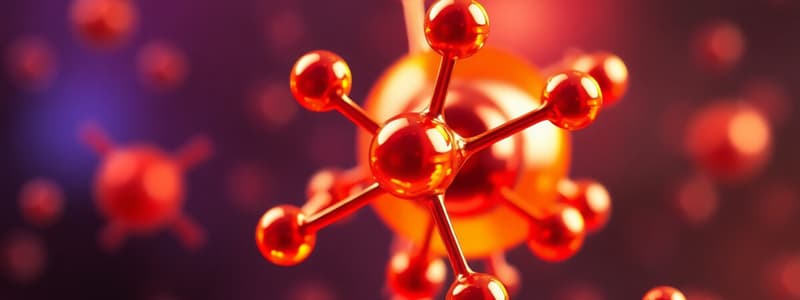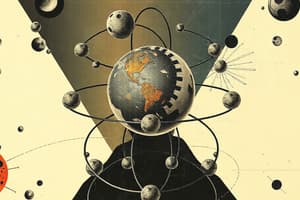Podcast
Questions and Answers
Match the definitions with the correct terms related to matter:
Match the definitions with the correct terms related to matter:
Matter = Anything that occupies space and has mass Atom = Smallest unit of a chemical element Vacuum = Volume of space without any matter Atomic Theory = Theory explaining the composition of matter
Match the ancient scholars with their contributions to the study of atoms:
Match the ancient scholars with their contributions to the study of atoms:
Democritus = Proposed the idea that matter is made of indivisible particles John Dalton = Developed the Atomic Theory based on scientific laws Aristotle = Believed in four elements; did not accept atomic theory Lavoisier = Formulated the Law of Conservation of Mass
Match the components of an atom with their descriptions:
Match the components of an atom with their descriptions:
Proton = Positively charged particle in the nucleus Neutron = Neutral particle in the nucleus Electron = Negatively charged particle orbiting the nucleus Nucleus = Center of the atom containing protons and neutrons
Match the types of matter with their classifications:
Match the types of matter with their classifications:
Match the scientific laws with their relevance to atomic theory:
Match the scientific laws with their relevance to atomic theory:
Match the following assumptions of atomic theory with their descriptions:
Match the following assumptions of atomic theory with their descriptions:
Match the following subatomic particles with their characteristics:
Match the following subatomic particles with their characteristics:
Match the following atomic models with their describers:
Match the following atomic models with their describers:
Match the following terms with their definitions:
Match the following terms with their definitions:
Match the following variables to their arithmetic properties in atomic structure:
Match the following variables to their arithmetic properties in atomic structure:
Match the following terms from the Middle Ages with their descriptions:
Match the following terms from the Middle Ages with their descriptions:
Match the following events with their significance during the Early Middle Ages:
Match the following events with their significance during the Early Middle Ages:
Match the following figures to their contributions to the Franks:
Match the following figures to their contributions to the Franks:
Match the following terms with their characteristics during the Middle Ages:
Match the following terms with their characteristics during the Middle Ages:
Match the following descriptions with the corresponding Middle Ages sub-period:
Match the following descriptions with the corresponding Middle Ages sub-period:
Match the following issues to their relevance during the Early Middle Ages:
Match the following issues to their relevance during the Early Middle Ages:
Match the following leaders to their notable actions:
Match the following leaders to their notable actions:
Match the following characteristics with their respective early medieval concepts:
Match the following characteristics with their respective early medieval concepts:
Match the following figures to their periods of influence:
Match the following figures to their periods of influence:
Flashcards
Matter
Matter
Anything that takes up space and has mass.
Atom
Atom
The basic unit of matter, tiny and indestructible.
Atomic Theory
Atomic Theory
The idea that matter is made of atoms.
Atomism
Atomism
Signup and view all the flashcards
Democritus
Democritus
Signup and view all the flashcards
Atomic Theory Assumptions
Atomic Theory Assumptions
Signup and view all the flashcards
Atom Structure
Atom Structure
Signup and view all the flashcards
Proton
Proton
Signup and view all the flashcards
Neutron
Neutron
Signup and view all the flashcards
Electron
Electron
Signup and view all the flashcards
Middle Ages
Middle Ages
Signup and view all the flashcards
Dark Ages
Dark Ages
Signup and view all the flashcards
Fall of Rome
Fall of Rome
Signup and view all the flashcards
Franks
Franks
Signup and view all the flashcards
Clovis
Clovis
Signup and view all the flashcards
Charles Martel
Charles Martel
Signup and view all the flashcards
Battle of Tours
Battle of Tours
Signup and view all the flashcards
Charlemagne (Charles the Great)
Charlemagne (Charles the Great)
Signup and view all the flashcards
Pope Leo III
Pope Leo III
Signup and view all the flashcards
Importance of the Church in the Middle Ages
Importance of the Church in the Middle Ages
Signup and view all the flashcards
Study Notes
Matter
- Matter is all substances that make up the universe
- Anything that occupies space and has mass is matter
- All matter is made of tiny, indestructible particles called atoms (Democritus)
- Matter can be classified as pure substances or mixtures
- Vacuum: any space that does not contain matter
Atoms
- Atoms are the basic building blocks of matter
- Atoms are made up of even smaller particles: protons, neutrons, and electrons
- Protons are positively charged particles
- Neutrons have no charge
- Electrons are negatively charged particles
- Protons and neutrons are located in the nucleus of the atom
- Electrons orbit the nucleus in shells (or orbitals)
Structure of an Atom
- Nucleus: The central, dense core of the atom containing protons and neutrons
- Electron shells/orbitals: Regions surrounding the nucleus in which electrons are found
Atomic Particles
- Protons: Positively charged (+) particles within the nucleus
- Neutrons: Neutral (no charge) particles found within the nucleus
- Electrons: Negatively charged (-) particles orbiting the nucleus
- Protons and neutrons are part of the nucleus, while electrons are outside the nucleus.
Subatomic Particles
- The nucleus (N+) is located in the center of the atom
- Protons and neutrons are referred to as nucleons
- The nucleus is densely packed region of protons and neutrons
- Nearly all the mass of an atom is found in the nucleus
- Protons are composed of up and down quarks
- Neutrons are composed of one up quark and two down quarks
- Electrons are free-moving particles around the nucleus
- Interactions between electrons cause chemical bonding
Determining Atomic Characteristics
- Atomic number = number of protons
- Number of electrons = atomic number (in neutral atoms)
- Number of neutrons = mass number - atomic number
- Mass number = protons + neutrons
- If an ion has a charge it will either lose or gain electrons, these changes will affect the number of electrons, so you must calculate the number of electrons accordingly
- The charge of an atom is determined by the difference between the number of protons and electrons
Molecules
- Molecules are groups of two or more atoms bonded together
- They are the smallest units of a pure substance that can take part in chemical reactions
- Molecules can have simple, complex or repeating structures
Studying That Suits You
Use AI to generate personalized quizzes and flashcards to suit your learning preferences.





